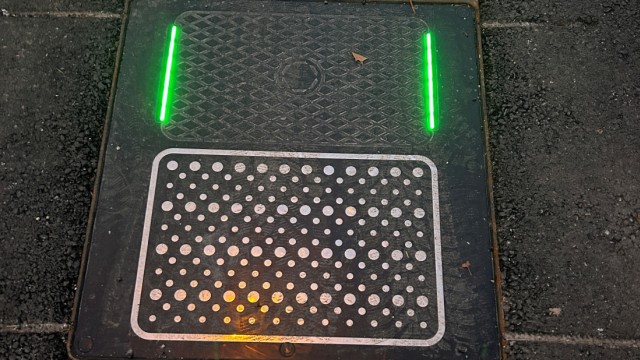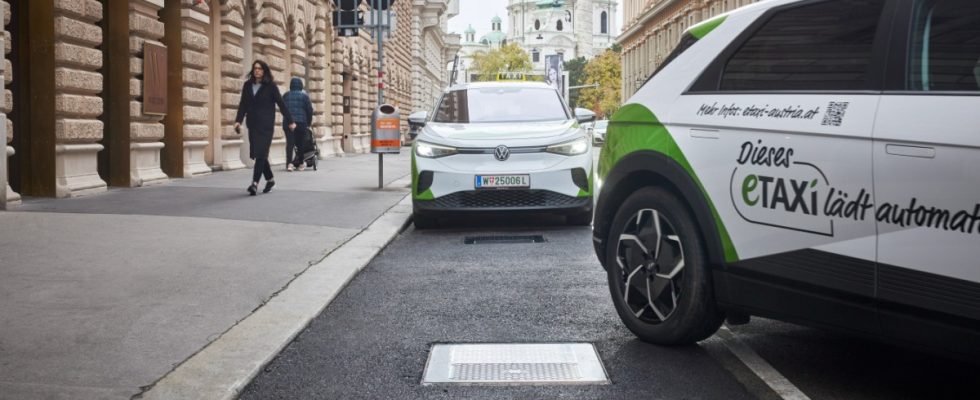Hermann Stockinger can still remember when the idea came to him, which led him to quit his job at BMW shortly afterwards. It was in the late summer of 2015 on the way home from work, he was cycling past the Munich Olympic Tower. Stockinger was 27 years old at the time, an engineer at the beginning of his career. But on that summer evening on his bike seven years ago, he thought to himself: Wouldn’t it be practical if you could charge an electric car without a cable? A device in the vehicle floor that extends and connects to a charging mat on the street – this is how Stockinger imagined automated charging at the time. Today he is the boss of his own company in Graz – and wants to soon offer his charging solution without cables to several major car manufacturers.
It’s basically about the answer to the question: What comes after – or next to – the charging station? Electric cars are still clearly in the minority on the roads. Depending on the region, it can currently take a while to even find a charging option. The federal government’s master plan promises one million publicly accessible charging points by 2030. So far, most people have assumed that this means charging stations where you have to plug and unplug a thick power cable. But as some companies realized years ago, this does not have to be the only solution. Especially since it is not barrier-free and you cannot set up large charging devices in every place. In addition: If cars soon drive autonomously, why shouldn’t they also be able to charge automatically?
Hermann Stockinger, founder and managing director of the company Easelink in Graz.
(Photo: Easelink)
The idea from Hermann Stockinger and his Graz company Easelink relies on so-called matrix charging. Stockinger first heard about this technology during his time at BMW, but he didn’t give himself much chance of implementing his idea within the company. At that time they were committed to a different technology, inductive charging. Smartphone owners use this technique when they place their cell phone on a surface to charge it wirelessly. Like BMW, several car manufacturers have tried inductive charging options for cars in recent years. The Munich-based company even brought a type of charging mat onto the market, but only for one of their plug-in hybrid models. Since then, nothing has happened in terms of inductive charging. The same happened to other manufacturers who were researching wireless charging: none of them offer a finished product today.
So far, inductive charging has failed primarily because of the costs
The technology is not the problem. Pilot projects have long been underway, for example on highway sections in Scandinavia and the USA. A route is also scheduled to go into operation in northern Bavaria in 2025. However, it is always about trucks, not cars. They drive over coils installed in the road and charge themselves in the process. But there remain unanswered questions, not only about its suitability for everyday use, but above all about the costs. Because where the smartphone rests closely on the charging mat, there is always a large gap between the ground and the vehicle in a car. There will always be charging losses when electricity is transferred from the ground to the battery. And the technology must be so safe that, for example, a cat that walks under a stationary car during the charging process is not harmed. It also requires high-performance electronics. All of this makes inductive systems expensive. This is probably the main reason why there is currently no inductive offer for private cars. Easelink wants to offer its charging pads for e-car drivers in 2025. Costs including the connector on the vehicle: around 2500 euros.
In cooperation with the energy supplier Wien Energie, the company has started converting taxis and installing charging plates in the asphalt in Vienna and Graz. Namely where the drivers are waiting for new customers. A total of 66 cars will be equipped with the charging system. The Easelink charging pads, which are visually reminiscent of large manhole covers, are currently embedded in the ground in six parking spaces; 23 taxis can already use them.

This is what the Easelink charging mat looks like, which is installed in the floor.
(Photo: Christina Kunkel)
Snow, ice, dirt – none of this is a problem for the system, says company boss Hermann Stockinger. The taxi project is also intended to prove this: that the charging solution can survive the toughest conditions. Above all, it should show why the technology is better than a normal charging station. Taxi services are ideal for this. Since the drivers keep rolling forward a few meters while waiting for customers, it is particularly convenient for them not to have to get out and plug and unplug a cable.
If the Easelink fails in Vienna, the city will have a problem
A few years ago, the city of Vienna launched a charging project for taxi drivers. They were given exclusive fast charging stations that they could reserve. However, they had to move away from their stand. There was no success. But new charging options have to be created quickly because Vienna only wants to allow emission-free taxis from 2025, as does Hamburg – and it would not be structurally possible to set up standard charging stations at some locations. This means: If the Easelink project fails, the city will also have a problem. Subsidies for the purchase and free electricity still attract taxi drivers to take part in the project. But Easelink will not become profitable from taxis alone, even if other cities are already showing interest in the charging pads.

The driver can use an app on his cell phone to see whether he has positioned the car correctly over the charging pad.
(Photo: Christina Kunkel)
In the end, the car manufacturers will also decide who prevails in the charging technology competition. Both inductive charging and matrix technology require parts to be installed on the vehicle. To do this, manufacturers must agree on a standard – and ideally offer this charging option in every electric car ex works. That’s why Hermann Stockinger is currently trying to convince car manufacturers to adopt a common standard for matrix charging. Several international manufacturers already have Easelink on board, says the Austrian. The company has its closest ties to Audi. It is possible that the VW subsidiary will be the first car brand to offer Matrix charging pads.
And yet times are difficult for new technologies. “The car manufacturers have recently had other problems,” says Benedikt Schmülling, who works on electromobility and energy storage systems at the University of Wuppertal. After many projects for inductive charging were not ready for series production, manufacturers initially concentrated on the cars themselves and on optimizing standard charging via cable, for example through shorter charging times. Nevertheless, Schmülling sees potential for automated charging in the coming years. He even believes that there can be several technologies coexisting – both inductive charging and a solution like Easelink offers.

